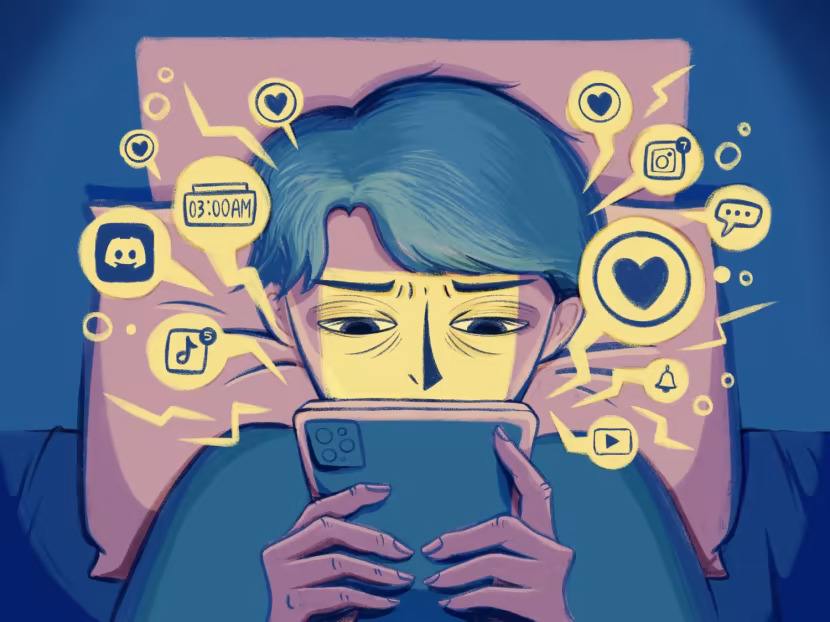What Is Doomscrolling Addiction?

In the age of constant connectivity and the 24/7 news cycle, a new behavioral phenomenon has emerged that psychologists and cognitive scientists are only beginning to understand. Dubbed “doomscrolling addiction,” this compulsive behavior refers to the endless consumption of negative news and content on digital devices, especially through social media and news platforms. This article delves into the psychological and cognitive dimensions of doomscrolling addiction, exploring why people engage in it, the impact on mental health, and possible interventions to break the cycle.
The Nature of Doomscrolling Addiction

Doomscrolling addiction can be understood as a repetitive, compulsive behavior where individuals continuously consume distressing or pessimistic news. Much like other forms of addiction, doomscrolling hijacks the brain’s reward system, pulling individuals into an unending cycle of content consumption, despite the negative emotional consequences.
At its core, this addiction stems from the basic human need for information, especially when it pertains to potential threats. Evolutionarily, humans have developed a cognitive bias towards negative information—often called “negativity bias”—as a means of survival. Negative events signal danger, and by paying attention to them, early humans were better able to protect themselves from harm. In the modern world, this bias persists, making us more likely to engage with negative news. When paired with the algorithmic designs of social media platforms that prioritize engagement, it creates the perfect storm for doomscrolling addiction.
Psychological Mechanisms Behind Doomscrolling Addiction

The psychological mechanisms that drive doomscrolling addiction are multifaceted. One of the key elements is the concept of intermittent reinforcement, which is a hallmark of many addictive behaviors. In this addiction, individuals are intermittently rewarded with information that feels urgent or important, even though the vast majority of the content is distressing or irrelevant. This unpredictability keeps people scrolling in the hopes of finding something significant, much like a gambler at a slot machine.
Moreover, the fear of missing out (FOMO) plays a significant role in perpetuating doomscrolling addiction. In an era where news travels fast and social media amplifies every development, individuals often feel an acute need to stay updated, lest they miss out on critical information. This constant need to remain informed, however, can easily spiral into a compulsive pattern, contributing to this addiction.
Anxiety and uncertainty are also psychological triggers that feed into doomscrolling addiction. With global crises, political turmoil, and public health concerns frequently dominating headlines, people may turn to doomscrolling as a way to cope with their anxieties. Ironically, while the intent might be to gain control over uncertain situations by gathering more information, the constant exposure to negative news exacerbates feelings of helplessness and despair.
Cognitive Impacts of Doomscrolling Addiction
From a cognitive perspective, doomscrolling addiction has significant implications for mental processes such as attention, memory, and decision-making. Attention is one of the primary cognitive functions affected by this addiction. Social media and news platforms are designed to capture and hold our attention, often through emotionally charged content. When individuals engage in doomscrolling addiction, their attention becomes fragmented, leading to difficulty focusing on tasks that require sustained concentration. This can result in a phenomenon known as attentional fatigue, where the brain becomes overloaded by constant stimuli, reducing cognitive efficiency.
Memory, particularly working memory, is also impacted by doomscrolling addiction. Working memory is responsible for holding and manipulating information in the short term, and it is essential for decision-making and problem-solving. However, when individuals are constantly bombarded with negative information through this addiction, their working memory can become overloaded with irrelevant or distressing content. This can impair the ability to process new information effectively, leading to difficulties in decision-making and an increased likelihood of cognitive errors.
Furthermore, doomscrolling addiction can lead to cognitive distortions, where individuals begin to perceive the world through a more negative lens than is warranted by reality. This can manifest as catastrophizing, a cognitive distortion where individuals expect the worst possible outcomes in any situation. As individuals continue to engage in doomscrolling addiction, their cognitive framework may shift towards a more pessimistic and anxious perspective, reinforcing the addictive behavior and contributing to a vicious cycle of negativity.
The Role of Technology in Doomscrolling Addiction

The technological environment in which we live plays a crucial role in the development and maintenance of doomscrolling addiction. Social media platforms, news websites, and even search engines are designed to maximize user engagement through algorithms that prioritize emotionally charged and attention-grabbing content. These algorithms often amplify negative news, which can feed into the compulsive behavior characteristic of this addiction.
Moreover, the infinite scroll feature commonly found on social media platforms is particularly conducive to doomscrolling addiction. By eliminating natural stopping points, infinite scroll encourages users to keep consuming content without pausing to reflect or disengage. This design element taps into the brain’s reward system, reinforcing the behavior and making it harder to break free from doomscrolling addiction.
Notifications and alerts also contribute to doomscrolling addiction by constantly pulling individuals back into the digital space. Each notification represents a potential source of important or urgent information, which can trigger the brain’s reward system. This constant state of alertness makes it difficult for individuals to disengage from their devices, perpetuating this addiction.
The Mental Health Consequences of Doomscrolling Addiction
The mental health consequences of doomscrolling addiction are profound. Prolonged exposure to negative news can lead to increased levels of stress, anxiety, and depression. Research has shown that individuals who consume large amounts of negative news are more likely to experience symptoms of anxiety and depression, even if they were not directly affected by the events being reported.
this addiction also contributes to sleep disturbances. The blue light emitted by screens, combined with the emotional arousal from consuming distressing content, can interfere with the natural sleep-wake cycle. This can lead to difficulty falling asleep, poor sleep quality, and even insomnia, all of which can further exacerbate the mental health impacts of this addiction.
In addition to these emotional and psychological consequences, doomscrolling addiction can strain social relationships. Individuals who are consumed by doomscrolling may become emotionally withdrawn or preoccupied, leading to difficulties in maintaining healthy social connections. This social isolation can further contribute to feelings of loneliness and despair, creating a feedback loop that reinforces this addiction.
Breaking the Cycle of Doomscrolling Addiction

Breaking free from doomscrolling addiction requires both psychological and behavioral interventions. One effective approach is to practice mindfulness and self-awareness. By becoming more conscious of the emotional and cognitive impacts of doomscrolling, individuals can begin to recognize the signs of addictive behavior and take steps to disengage.
Cognitive-behavioral therapy (CBT) is another valuable tool for addressing doomscrolling addiction. CBT can help individuals identify and challenge the cognitive distortions that perpetuate their addiction, such as catastrophizing and black-and-white thinking. By replacing these distortions with more balanced and realistic thoughts, individuals can reduce their reliance on doomscrolling as a coping mechanism.
Setting digital boundaries is also essential in breaking the cycle of this addiction. This can include limiting the amount of time spent on social media or news platforms, turning off notifications, and establishing designated times for checking the news. By creating these boundaries, individuals can regain control over their digital consumption and reduce the compulsive behaviors associated with doomscrolling addiction.
Additionally, engaging in positive activities that promote mental well-being can help counterbalance the negative effects of this addiction. Activities such as exercise, meditation, and spending time in nature have been shown to reduce stress and improve mood. By incorporating these activities into their daily routine, individuals can create a healthier balance between digital consumption and real-world experiences.
Conclusion
Doomscrolling addiction is a modern phenomenon that has significant psychological and cognitive implications. Driven by a combination of evolutionary biases, technological design, and emotional triggers, this compulsive behavior can have detrimental effects on mental health and cognitive functioning. However, by understanding the mechanisms behind doomscrolling addiction and implementing strategies to break the cycle, individuals can regain control over their digital consumption and improve their overall well-being.
As we continue to navigate the digital age, it is crucial to remain mindful of how our interactions with technology impact our mental and cognitive health. By addressing doomscrolling addiction head-on, we can foster healthier relationships with our devices and cultivate a more balanced approach to information consumption.
